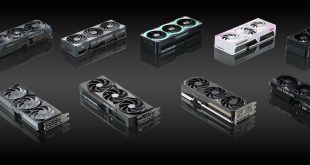The XFX HD7950 Black Edition arrives in a typically ‘dramatic' XFX box, featuring space age artwork. You can't knock XFX for presentation.
The XFX bundle is strong, with literature on the product and their power supplies and a little installation guide. They also include a very nice metal badge, software disc, video converter cable and Crossfire cable.
The XFX HD7950 BE is just as attractive as the HD7970 which we reviewed early January. It really does stand out on a visual level.
XFX are using a dual fan configuration housed in a metal cooler. Down the top is a metallic red strip with the name of the product along with ‘Ghost – Thermal Technology’ branding.
So what exactly is ‘Ghost – Thermal Technology’? XFX say “Through rigorous testing and analysis we have discovered the optimal thermal design that allows air to pass through the heatsink directly to the PCB and core components. Older enclosed designs often trapped the heat, creating a bottle neck at the exhaust, this can be remedied but at the cost of a higher fan speed which creates excess noise. Our design allows us to keep the fan speeds lower while allowing the heat to dissipate evenly throughout the card.”
This card is using two large fans which are IP-5X designs, offering protection against dust and other small foreign objects which can cause long term damage. This will help ensure maximum performance, even several years down the line. That said, we do recommend that you remove your video card every couple of months for cleaning.
XFX state that these fans last up to 10,000 hours longer than traditional designs.
The XFX HD7950 BE is Crossfire capable in 2,3 and 4 way configurations. The card uses a dual BIOS switch, which can store two different configurations.
XFX's key objective is to offer the gamer the choice to enhance their gaming experience based on their preferences. The cards will be shipped with the Standard Gamer Profile – however once the consumer registers their card as part of their 5 Star Support system this will immediately let the customer know that they have two options for the BIOS.
Enthusiast Gamer Profile BIOS – 795ANORD
This profile has a higher RPM profile that will run cooler but will record a higher Db level on the acoustics – So ideal for the competent DIY gamers that like to tune the card further and are happy to flash the BIOS.
Standard Gamer Profile BIOS – 795ANOR1
This profile has a lower RPM profile that will run warmer but will emit less noise.
Before launch we received five or six bioses from XFX, making it a little hard to follow which was which. We used the enthusiast bios for testing, which has a slightly more aggressive fan profile. All bios profiles use the same core and memory clock speeds.
The card is a dual slot design with a full sized DVI and HDMI port, and two mini Display Port connectors. It is Eyefinity capable and can power up to 6 displays. This solution can simultaneously output multiple, independent audio streams from the HDMI and mini Displayport connectors at the rear of the card. The GPU can support 3GHz HDMI with frame packing support for Stereo 3D.
XFX seem to be the only manufacturer who put ‘warranty invalidated' stickers on their rear mounted cooler screws. While we can understand this concept with a power supply I personally don't like this restriction with a graphics card. I always disassemble before testing to check the thermal paste is applied properly (it often isn't). I tend to replace the paste immediately with my own and im sure many enthusiast users are the same. Ditch the stickers XFX and offer a full warranty, regardless. Please!
The card takes power from two 6 pin PCI e power connectors.
XFX are using a proprietary cooler which is built around a fantastic looking PCB, as shown above. XFX are using high quality HYNIX GDDR5 memory, and a Chil CHL8228G controller which is the same as the HIS HD7950.
The XFX HD7950 Black Edition is the fastest clocked card we are looking at today, with a 100mhz core clock increase (from 800mhz to 900mhz). The GDDR5 memory is also overclocked, from 1,250mhz (5,000 mhz effective) to 1375mhz (5,500 mhz effective). This is connected via a 384 bit memory interface. The card is equipped with 32 ROPS and 1792 unifed shaders, which is down from 2048 on the higher cost HD7970.
 KitGuru KitGuru.net – Tech News | Hardware News | Hardware Reviews | IOS | Mobile | Gaming | Graphics Cards
KitGuru KitGuru.net – Tech News | Hardware News | Hardware Reviews | IOS | Mobile | Gaming | Graphics Cards



















great looking board, but it looks like it might be more than £400………
I love the look of this card, like the 7970. Still too much cash for most people, they need a good performing card around £200. not £350-£500. very few people can afford any of these cards
Not questioning the hardware, but its such a small market. Im more interested in the £150 sector. and what AMD can do for that.
isn the logical move to buy the cheapest 7950 and just overclock the nuts off it ? dont see any need to spend a lot more above this, for a cooler.
Dont see this version on sale yet.